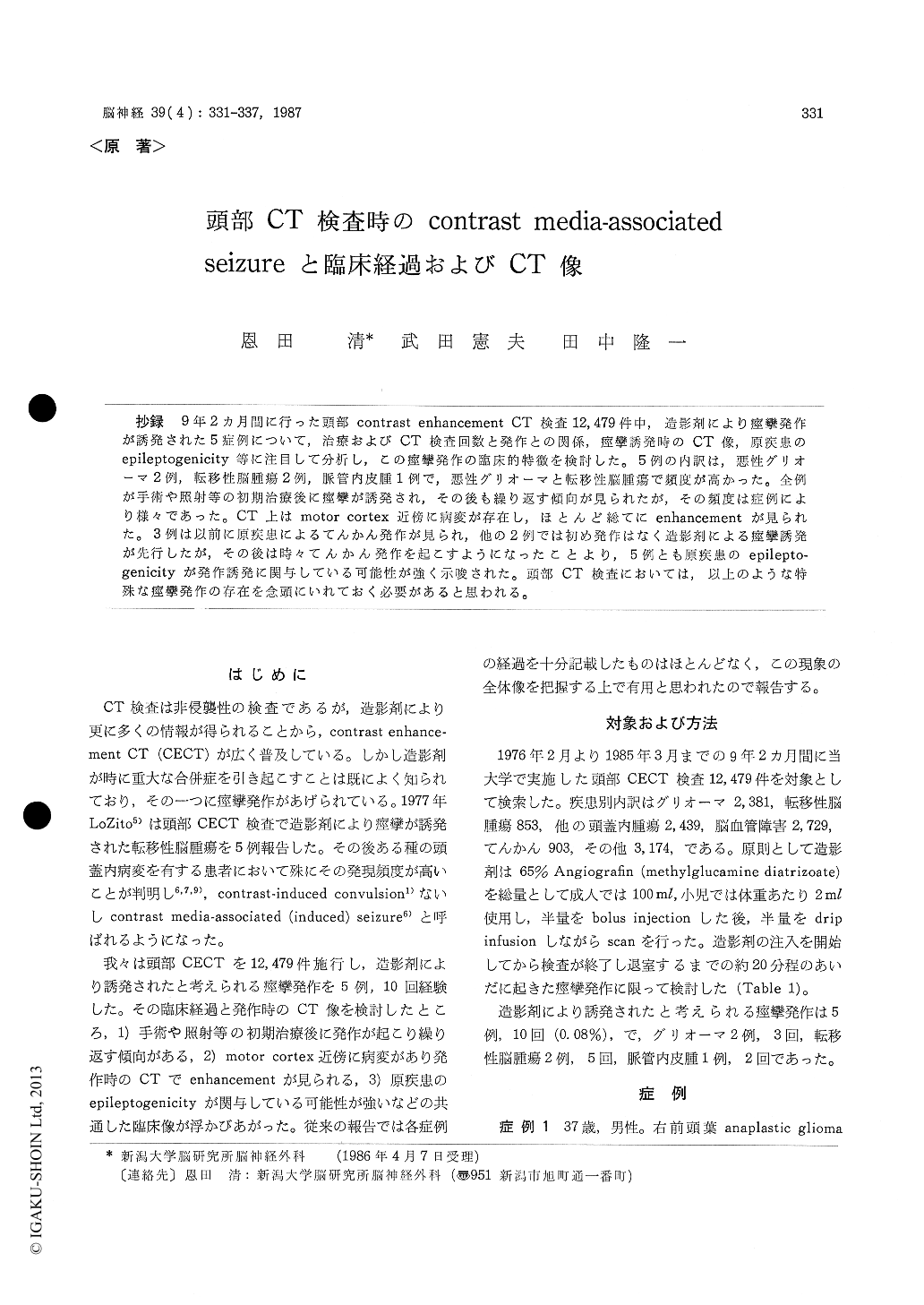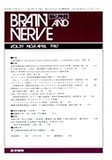Japanese
English
- 有料閲覧
- Abstract 文献概要
- 1ページ目 Look Inside
抄録 9年2ヵ月間に行った頭部contrast enhancement CT検査12,479件中,造影剤により痙攣発作が誘発された5症例について,治療およびCT検査回数と発作との関係,痙攣誘発時のCT像,原疾患のepileptogenicity等に注目して分析し,この痙攣発作の臨床的特徴を検討した。5例の内訳は,悪性グリオーマ2例,転移性脳腫瘍2例,脈管内皮腫1例で,悪性グリオーマと転移性脳腫瘍で頻度が高かった。全例が手術や照射等の初期治療後に痙攣が誘発され,その後も繰り返す傾向が見られたが,その頻度は症例により様々であった。CT上はmotor cortex近傍に病変が存在し,ほとんど総てにenhancementが見られた。3例は以前に原疾患によるてんかん発作が見られ,他の2例では初め発作はなく造影剤による痙攣誘発が先行したが,その後は時々てんかん発作を起こすようになったことより,5例とも原疾患のepilepto-genicityが発作誘発に関与している可能性が強く示唆された。頭部CT検査においては,以上のような特殊な痙攣発作の存在を念頭にいれておく必要があると思われる。
It is well known that convulsion is one of serious adverse reactions of x-ray contrast media. The occurrence of the convulsion seems to be very rare in general population. However, a few reports noticed recently that patients with brain meta-stases or gliomas developed this complication re-latively frequently and the terms, as contrast-induced convulsion or contrast media-associated (induced) seizure, were used.
We performed 12,479 cranial CT examinationswith contrast enhancement during the last nine years. The amount of 100 ml in adult or 2ml/kg in children of 65% Angiografin (methylglucamine diatrizoate) was given intravenously and five pa-tients had contrast media-associated seizures.
Case 1: A 37-year-old man with right frontal anaplastic glioma was treated surgically and with radiochemotherapy and hyperthermia. In spite of anticonvulsant therapy, general or left hemicon-vulsions occurred sometimes. The patient had contrast-induced general convulsion at 16th CT examination which revealed enhancement in the wall of surgical tissue defect. At 26th CT study, he developed general convulsion again.
Case 2 : A 47-year-old man with anterior callosal anaplastic glioma was treated surgically and with radiochemotherapy and hyperthermia. After then, he had contrast media-associated general convul-sion at 10th CT examination which showed en-hanced lesions.
Case 3 : A 63-year-old woman had been treated surgically for lung cancer. Five years later, CT revealed a ring enhancement in the left frontal lobe. Radiation reduced the lesion gradually. At 6th and 10th CT examinations, the patient deve-loped contrast-induced right focal or general con-vulsion, respectively. Only one epileptic attack occurred the day before 6th CT study.
Case 4 : A 56-year-old woman had been treated surgically for breast cancer. Four years later, CTshowed left hemispheric multiple enhanced lesions. Radiation was a little effective but, several months later, metastases progressed again. At first, she had no epileptic attack and was treated with prophylactic anticonvulsants. At 5th CT study, contrast media-associated right focal convulsion was developed. Then epileptic attacks began to occur. At 10th and 11th CT examinations, similar contrast-induced focal convulsions were developed.
Case 5: A 49-year-old man with right frontal hemangioendothelioma was treated surgically and with radiation, and the lesion decreased gradually. The patient had no epileptic attack and was treated with prophylactic anticonvulsant like case 4. At 7th and 8th CT studies, he had contrast media-associated left focal or general convulsion, respectively. Then similar epileptic attacks began to occur.
These five cases had some common clinical features as follows ; 1) First contrast-induced con-vulsion was developed after completion of initial treatments of surgical intervention and/or radio-therapy. 2) CT showed varied enhanced lesions near the motor cortex almost every time when contrast media-associated seizure occurred. 3) Ep-ileptogenicity due to the tumors seems to play an important role for the development of this special convulsions after contrast media injection.

Copyright © 1987, Igaku-Shoin Ltd. All rights reserved.


